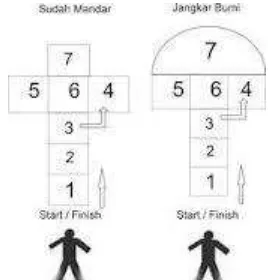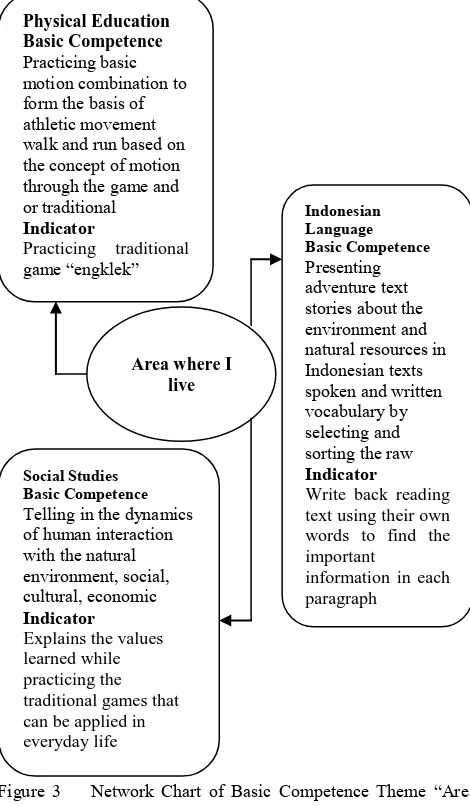2nd International Seminar on Quality and Affordable Education 2013
Utilization of Cultural Objects as Learning Media Themes “Area
Where I Live” in The Fourth Grade Elementary School: A Study of
The Implementation of Integrative Thematic Approach
Sekar Purbarini Kawuryan
Faculty of Education, Yogyakarta State University, Indonesia [email protected]
Abstract
Indonesian diversity consists of so many islands connected by the sea, rich ethnic, tribe, language, culture, religion, and customs. The richness of culture needs to be preserved, developed, and utilized by every human being in Indonesia. Therefore, the role of education through school is important. Value of local wisdom can be appreciated if properly recognized. If these values were not preserved and maintained, it will feared gradually through the process of extinction. One of the efforts to preserve it is through the utilization of local culture objects as media in the learning process in schools. Cultural property which is referred to in this paper adapted to the basic competence of the subjects that are integrated into a single theme. Examples, theme "Regional where I live" is telling in the dynamics of human interaction with the natural environment, social, cultural, economic, practicing basic motion combination to form the basis of athletic movement walk and run based on the concept of motion through the game and or traditional, and presenting adventure text stories about the environment and natural resources in Indonesian texts spoken and written vocabulary by selecting and sorting the raw. Through these themes, fourth grade student facilitated and guided to learn thematically integrative use of cultural objects available in the surrounding environment.
Keywords: Utilization; cultural objects; learning media; elementary school; integrative thematic approach
Abstrak
Keanekaragaman Indonesia terdiri dari banyak pulau yang dihubungkan oleh lautan, kekayaan etnis, suku, bahasa, budaya, agama, dan kebiasaan. Kekayaan budaya tersebut perlu dilestarikan, dikembangkan, dan dimanfaatkan oleh seluruh masyarakat Indonesia. Peran pendidikan melalui sekolah menjadi penting untuk mengembangkan hal tersebut. Nilai kearifan lokal dapat dihargai jika nilai tersebut dikenali dengan baik. Nilai kearifan lokal jika tidak dijaga dan dipelihara dikhawatirkan secara berangsur-angsur akan mengalami proses kepunahan. Salah satu upaya untuk menjaganya adalah melalui pemanfaatan benda budaya lokal sebagai media dalam proses pembelajaran di sekolah. Benda budaya yang dimaksud dalam tulisan ini disesuaikan dengan kompetensi dasar mata pelajaran yang
diintegrasikan dalam satu tema. Contohnya, tema “Daerah Tempat Tinggalku” dengan kompetensi dasar memahami manusia dalam dinamika interaksi dengan lingkungan alam, sosial, budaya, dan ekonomi (IPS), mempraktikkan kombinasi gerak dasar untuk membentuk gerakan dasar atletik jalan dan lari yang dilandasi konsep gerak melalui permainan dan atau tradisional , dan menggali informasi dari teks cerita petualangan tentang lingkungan dan sumber daya alam dengan bantuan guru dan teman dalam bahasa Indonesia lisan dan tulis dengan memilih dan memilah kosakata baku. Melalui tema ini, siswa kelas IV difasilitasi dan dibimbing untuk belajar secara tematik integratif menggunakan benda budaya yang tersedia di lingkungan sekitarnya.
Kata kunci: Pemanfaatan; benda budaya; media pembelajaran; sekolah dasar; pendekatan tematik integratif
1.0 INTRODUCTION
Indonesian community is known as the diversity nation's.1
Indonesian diversity consists of many islands that connected by the ocean, richness ethnic, ethnicity, language, culture, religion, and customs. Uniqueness and peculiarities of a particular culture is a potential that can be processed to penetrate today's global culture. Therefore, the richness of Indonesian culture needs to be explored and introduced and also developed by every human being in Indonesi.
1
Sultan Hamengku Buwono X, Merajut kembali keIndonesiaan kita, Jakarta, Gramedia, 2007, hal 21.
The role of education through school becomes important to develop it. The value of local knowledge can be appreciated if it well recognized. If not preserved and maintained, it will feared gradually through the process of extinction. In this context, the existence of the community as a source of local values-traditional can be used to enrich the material that has been written in the book. This is in accordance with the opinion of Tilaar2 that values, morals, habits, customs/traditions, and culture to be certain in the daily life are things that need to be known and studied by
2
students. This opinion was reinforced by Nasir & Hand that …”research on race, culture, and schooling has revealed many significant factors affecting school achievement and has articulated many details of how culture and learning intersect in
daily school life”.3
One of the efforts to preserve the values of local wisdom is through the utilization of local cultural objects in the learning process in schools. Cultural objects which is Koentjaraningrat4 say as physical culture man's work used as learning media. Cultural objects defined in this paper are in the form of all physical results, ranging from activities, actions, and man's work in the community which is concrete, can be seen, felt and touched, or looked physically. Benefits to be gained from the use of these cultural objects are at least three. First, students are not cut off from their cultural roots and being familiar with their daily environment, second multicultural spirit or consciousness that as a nation we are plural can be implanted from the beginning, and the third is learning not only textual but contextual.
The results of Sekar Purbarini Kawuryan5 showed that utilization of cultural objects in the process of elementary social studies learning can improve the quality of student learning outcomes. Subsequent research6 on social studies learning based on the knowledge of Java’s human life cycle as local wisdom also proven effective for improving student religiosity.
3 Nasir, N. S., & Hand, V. M, Exploring sociocultural perspectives on
race, culture, and learning, Review of Educational Research, 76, 2006, 449-475.
4
Koentjaraningrat, Pengantar ilmu antropologi, Jakarta, Rineka Cipta, 1990, hal 187 mengemukakan ada tiga kelompok wujud kebudayaan, yaitu: (1) wujud kebudayaan sebagai sistem budaya yang berupa ide-ide, gagasan, nilai-nilai, norma-norma, peraturan yang merupakan hasil pemikiran manusia; (2) wujud kebudayaan sebagai sistem sosial, yakni kebudayaan yang berupa aktivitas manusia dalam masyarakat. Budaya ini merupakan perilaku nyata manusia dalam kehidupan sehari-hari; dan (3) wujud kebudayaan sebagai kebudayaan fisik yang berupa benda-benda hasil karya manusia yang digunakan dalam kehidupan.
5
Sekar Purbarini Kawuryan, Pemanfaatan potensi budaya lokal untuk meningkatkan kualitas pembelajaran IPS SD, Tesis Magister, Tidak Diterbitkan, Yogyakarta, Universitas Negeri Yogyakartta, 2009.
6
2.0 EXPERIMENTAL
Utilization of cultural objects in the previous studies are limited in social studies. This paper attempts to offer new ideas to take advantage of cultural objects in some subjects are tied to a single theme, namely “area where I live" with thematic integrative approach. This learning approach integrates the various competences of different subjects into various themes. The integration is done in two ways, namely the integration of attitudes, skills and knowledge in the learning process and the integration of the basic concepts related.
3.0 RESULTS AND DISCUSSION
Application of thematic integrative approach using cultural objects as media in the learning process in elementary schools in this paper is focused on the theme of "area where I live". The main reason for the selection of this theme is compatibility with local cultural objects close to the surrounding environment and can be used in the students' learning process. In this context, the cultural objects referred is human activities that appear physically, which is a game of “engklek” (hopscotch). drawn on the ground or floor. In order to play, each child must be armed with gacuk which is usually a form of tile fragments, which are also called kreweng, In the game, this kreweng placed in one of the plots which envisaged in the soil by thrown. Plot which is a gacuk in there should not be trampled/occupied by each player, The player should jump to the next plot with one foot around the existing plots. Players who have completed the first round, can choose a plot to be their "rice field", which means in the plot the player can step on it with both feet, while other players can not step on the plot during the game. The winner is the participant who has the most boxes.
Figure 1 How to Play engklek (mixsand.blogspot.com)
7
http://id.wikipedia.org/wiki/Sunda_manda
Figure 2 Elementary students were playing engklek (bukitaksara.com)
Step-by-step implementation of integrated thematic approach to utilizing cultural objects are as follows.
1. Identify basic competence subjects
At this stage, we can start with recitation of the basic competency of a fourth grade subjects that can be taught using the theme "area where I live". The following tables are examples of subjects that can be integrated in a single theme.
Table 1 Identification of the Basic Competence Subjects for Themes "area where I live"
Physical
2. Establish indicators of each subject
This phase was conducted to determine the achievement of competence of the subjects that can be taught with the theme "area where I live" as in the example below.
Table 2 Indicators of Subjects in One Theme Physical
3. Linking basic competence and indicator with a unifying
theme
Figure 3 Network Chart of Basic Competence Theme “Area Where I Live”
4. Making Thematic Lesson Plan Implementation
Preparation of this lesson plan is a concrete manifestation of the learning experience that will be obtained by the student after through the learning process using cultural objects. Moreover, in this lesson plan can also be found way to assess student learning outcomes based on indicators that have been defined previously. Examples of learning activities are as follows.
(1) Students are required to observe the image, read the text of the play hopscotch on the student book and answer questions
(2) Students are given the opportunity to share their answers in pairs
(3) Students do engklek game
(4) Students discuss game activities that have been carried out with teachers
(5) Students write a story about his experience playing another traditional game based on the example set by the teacher
(6) Students discuss with the teacher the best paper as an example that can be discussed
(7) The students were briefed on how to behave when interacting and playing with different people
(8) Students are encouraged to connect the good things that come from the game with the character values such as tolerance, responsibility, teamwork, and discipline.
4.0 CONCLUSION
Cultural objects that are available in the environment surrounding students, which is define as an activity that can be seen and physically appear called engklek games can be used as a learning resource. Utilization of this cultural object is used as an integrative thematic learning media theme "area where I live" for subjects physical education, Indonesian language, and social studies. Benefits to be gained from the use of these cultural objects are students was not cut off from their cultural roots and being familiar with their daily environment, second multicultural spirit can be implanted from the beginning, and learning not only textual but contextual.
Acknowledgement. I would like to extend my gratitude especially to the Dean for giving permit to present my paper at Johor Bahru Malaysia and also I would like to say thanks to the committee of ISQAE 2013.
References
Koentjaraningrat. (1990). Pengantar ilmu antropologi. Jakarta: Rineka Cipta.
Nasir, N. S., & Hand, V. M. (2006). Exploring sociocultural perspectives on race, culture, and learning. Review of Educational Research, 76, 449-475.
Sultan Hamengku Buwono X. (2007). Merajut kembali keIndonesiaan kita. Jakarta: Gramedia.

